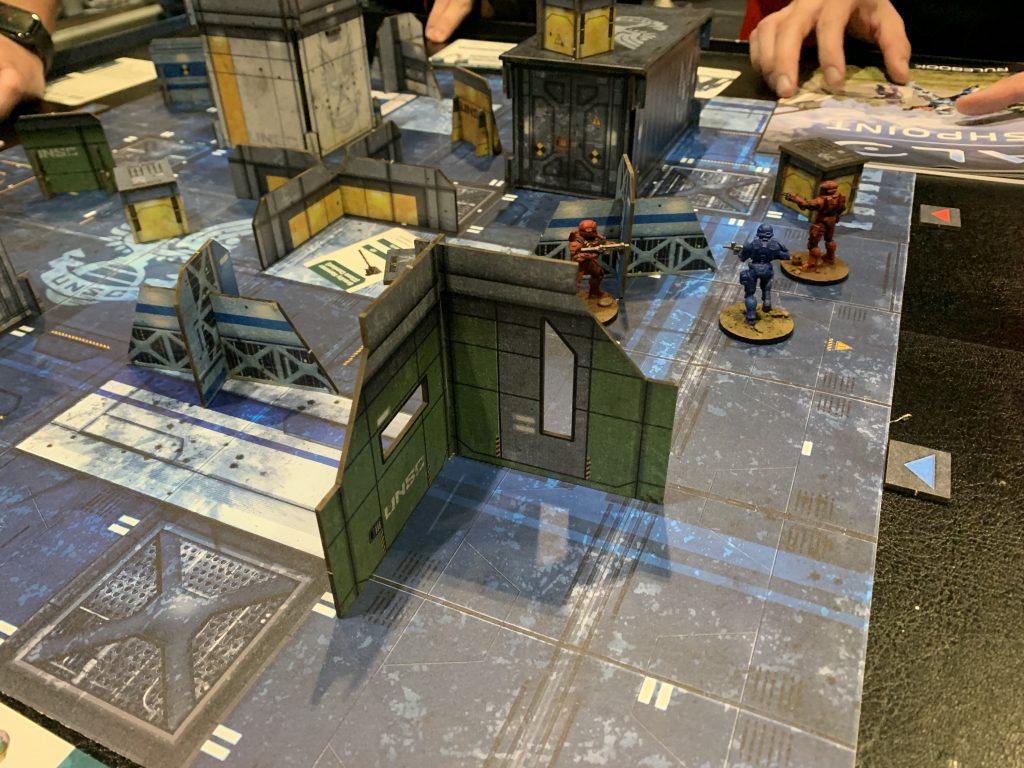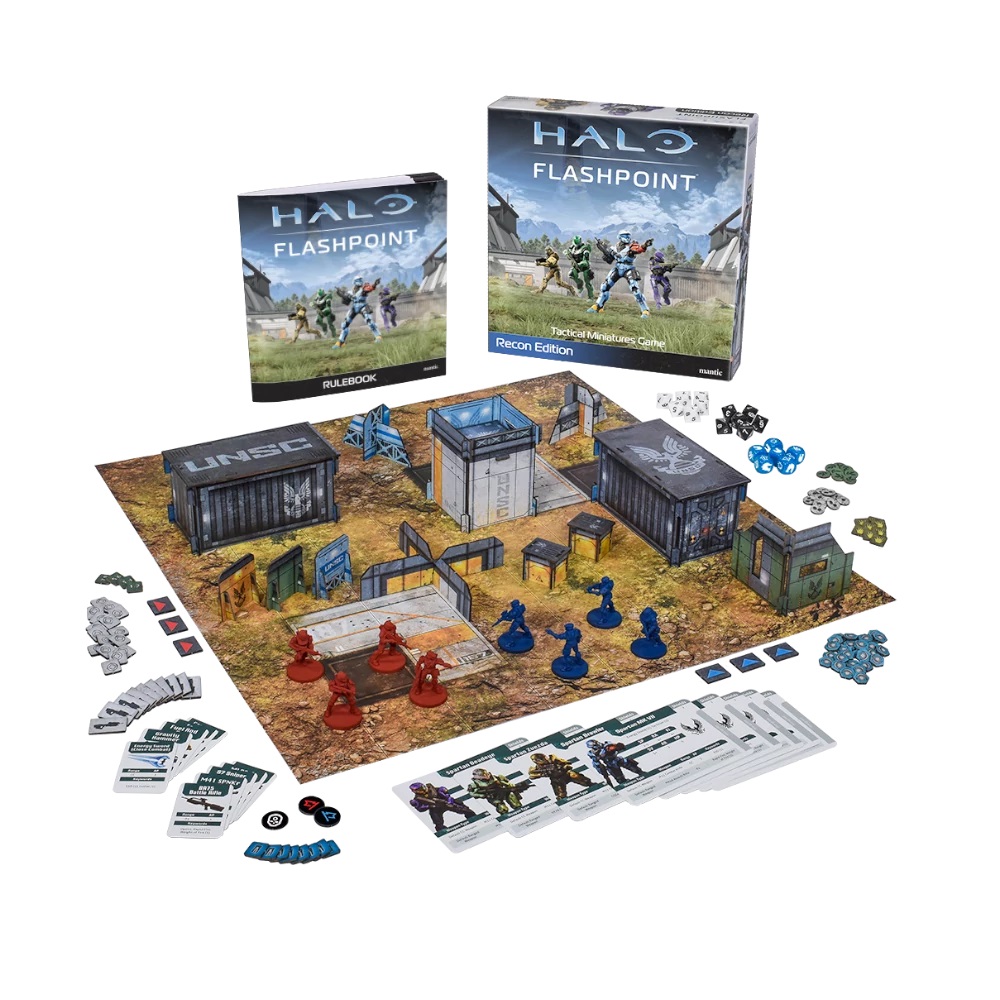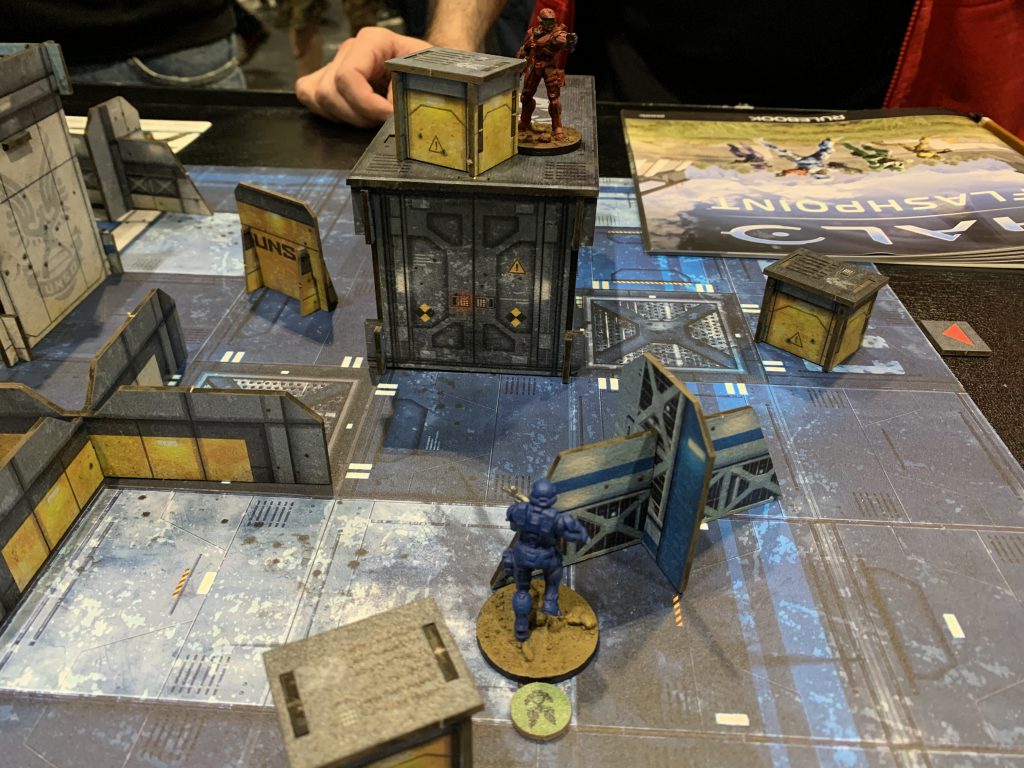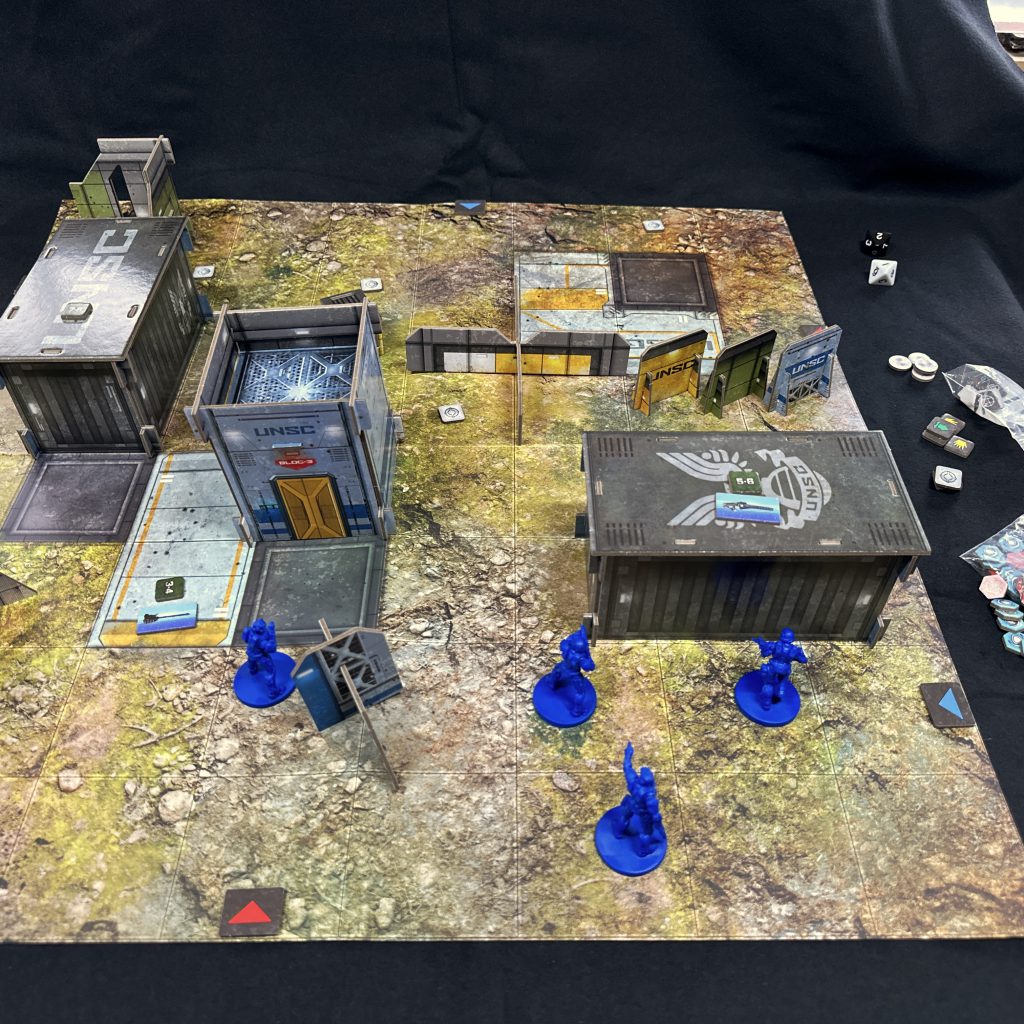I would like to thank Mantic Games for supplying a review copy of Halo: Flashpoint Recon Edition for this review.
Halo: Flashpoint is set within the sci-fi universe first established in Halo: Combat Evolved, a multi-decade franchise which takes place in the 26th century. Flashpoint sets out to capture the look, feel, and energy of the Halo multiplayer series with frenetic firefights and weapons from across the series.

When we spoke to Mantic back in September, they said one of the major goals with Halo was to provide a gaming experience that was ready to go straight out of the box, so let’s jump in to see what that looks like!
The Recon Edition comes with the following:
- 8 x Spartan models
- Rulebook
- Play mat
- Pre-coloured card terrain and tokens
- 10 x Weapon cards1
- 8 x Player/model cards
- 2 x Reference cards
- 12 x D8 dice
- 6 x Command dice

Your Spartans comprise two teams, with each team containing a Deadeye, Brawler, Zvezda, and Mk VII. The 32mm scale PVC models have well defined detail, with crisp armour lines and panels differentiating the armour types and battlefield roles. The two teams are cast in red and blue, so if you want to get them straight to the table and playing you can, with no need to paint.
There’s no need to open the rulebook for your first game and you can get straight to playing using the double-sided play mat. One side of the playmat has a 15″x15″ play area with all of the rules for an introduction game around the border, with the other side offering a full sized 2’x2′ arena. And the demo board really does have everything you need to get started, with all of the set up instructions, actions, model cards, keywords, and rules you need to immediately get going. If you’re looking to go for a full size game, then having a roughly 3’x3′ play area would be sufficient, to make sure you have space for tokens, item cards, and dice rolling.
The terrain is a good quality, thick cardstock, and should last a long time provided you take care assembling and disassembling if you’re putting everything away at the end of each session. I’d advise some extra care when removing the terrain pieces with the locking hooks, as I did manage to delaminate a couple as I was pushing them out of the sheets. The assembly instructions are clear, however I’d recommend a different approach for the towers. I found it very awkward to get the hooks enmeshed while also lining up the slots, and it’s actually much easier to line up the slotted pieces first and then hook the remaining sides on.
Having everything you need to start on your playmat is a great idea, and makes learning the game a really straight forward experience. I didn’t get a chance to read the full rulebook before we started, and my only other experience was the demo at Salute. Even with all of that said, it was super quick to get going and we had our first game wrapped in less than an hour.
With a taster round of Slayer under our belts, the group were keen to try a full sized game. I wanted to keep everyone engaged with the set up process, so had everyone from the group taking turns to roll dice for the item set up. It might have been faster to just hammer out eight items with one person rolling two distinct dice and one person dropping them on but this was more fun! From Round 2 onwards, items continue to drop in at random using the same co-ordinate based spawn system. Once the items are laid out, weapon drop markers are put in place following the scenario map. Players roll off to see who’s going first, with the winning player deploying all of their models first, followed by their opponent. Once your Spartans have taken to the arena, the first weapon drops in at random and you begin the game.

Slayer is the classic team deathmatch experience, and we played first to 8 kills. Our learning game had given us enough to get moving and it didn’t take long for teams to start trading shots. Team games will always take a little bit longer to play, discussion between players adding some time to that decision making process but even with this we had our Slayer game completed in around two hours.
If you’re familiar with Deadzone, then picking up the core mechanics of Halo is going to be very easy for you, however there were a couple of things that tripped up one of our players who was already familiar with the ruleset. It’s worth checking out the differences before you make assumptions, as Halo is a much faster and more lethal game. Cube based movement streamlines the process, with no need to measure while still allowing for tactical positioning for that perfect shot. The shooting rules are also smooth, with every attack starting at a base of three dice, applying (mostly) positive modifiers, and your range checking following the movement rules. For those experienced wargamers, being able to play by intent and keeping up communication with your opponent will definitely help to keep the game moving and we had a couple of situations when discussing line of sight where this helped immensely.
While the rules are mostly very clean we still had one or two instances where things weren’t totally clear. This is particularly important if the goal is to support broader tournament and competitive play. The first question the group had was around the Active Camouflage item. It prevents enemies from drawing line of sight to the user, but we couldn’t find anywhere in the rule book to confirm if this also prevented Assaults. Rules as written, Assaults do not require line of sight which means you can engage a model with Active Camouflage. The other interaction we won’t totally clear on, was whether the Lunge keyword allowed you to make a Shoot action with a melee weapon, and then move in for an Assault action. In the case of Active Camouflage, it feels like you shouldn’t be able to Assault a model under the effect, but rules as written you can. For weapons with the Lunge keyword, it would be useful to have clarification on whether they can be used in Assault.
Mantic have managed to strike a balance here with Halo: Flashpoint, offering a beer and pretzels experience for both people unfamiliar with boardgames, and seasoned wargamers. Using the core rules, you’re still offered interesting and important decisions in the moment to moment gameplay, without the rules getting in the way. Once you’re comfortable with the core rules you can add the team drafting and Recon test to the start of your games. The drafting mechanic sees players taking turns to pick models from shared pool, with Fireteams being faction locked. This works especially well if you have multiples of the same model and allows for more choices in the list building phase of setup. The Recon test is a taken at the start of the game, before deployment, and players compare successes. This test replaces the starting player role, and adds a step giving the winner and loser additional random bonus effects. Beat your opponent in the Recon roll and you might be able to advance to a better position, or start with additional items.

Final Thoughts
Mantic have captured the chaotic energy of the Halo FPS multiplayer experience with Flashpoint, and I’m excited to see what’s in store for 2025 and organised play. This game is straightforward enough that those without wargames experiences should still be able to pick it up and play easily, while still offering a tight and satisfying game to experienced players. Halo: Flashpoint is available as two separate editions, with the Recon edition being available for £60/$70 and the Spartan edition priced at £100/$125. You can order either of these, from the Mantic webstore.
I’d like to thank Adrian, Isaac, Martin, Peter, and Simon for playing a few rounds with me and getting some test games in. We had a great time testing the game modes and everyone was left wanting to play more.
Have any questions or feedback? Drop us a note in the comments below or email us at contact@goonhammer.com. Want articles like this linked in your inbox every Monday morning? Sign up for our newsletter. And don’t forget that you can support us on Patreon for backer rewards like early video content, Administratum access, an ad-free experience on our website and more.




